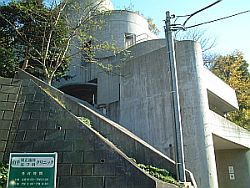Shane’s Japan Trip Report Day 15
Day 15: Italian Lunch in Motomachi, Yokohama
Today we took the Toyoko Line, which turns into the Minato Mirai Line, all the way to the last stop in Motomachi. From there, we strolled the length of Motomachi, checking out what new shops have arrived since our last visit and which are no longer there. I instantly felt like I had arrived back home, since this was my old neighborhood. We walked past Jooshuuya, the tiny corner grocery that I used to buy discounted sushi at after 9pm when I was a starving student. Then we hiked up the hill past what used to be the gaijin house that I lived in for two years. It has since been purchased and turned into a regular single-family house.
![]()
Visiting Friends in Yamate, Yokohama
We made our way to the top of the hill to an area called Yamate, and then made our way to our friend Nami-san’s house. I met Nami-san through a mutual friend in San Diego. Nami was living there for two years with her two children, Takumi and Aoi, as part of an “oyako ryugaku,” or parent-child foreign exchange. Nami is herself bilingual having spent much of her childhood abroad, and decided to raise her children bilingual as well.
Nami, like me, is a translator/interpreter/writer by trade. Her main line of work is interpreting for Western musicians who visit Japan, and as actually interpreted for some pretty famous artists. Whenever we meet we always brainstorm business ideas and talk about translation, language, etc. Recently Nami has started an eikaiwa, or English conversation, school, called Meme. She also recently had her second book published, this one about English pronunciation. Previously, she wrote a book in Japanese on how to write an English resume.
![]()
Italian Pasta Lunch in Motomachi
After hanging out at her house for a while, weat walked back down to Motomachi, and had lunch a little Italian bistro in Motomachi called Incontro. Motomachi, like many areas of Japan, is full of tiny little restuarants like this one. There is seating for perhaps 15-20 people. There is a single waitress and a single passionate chef in the kitchen pumping out amazing Japanese Italian pasta.
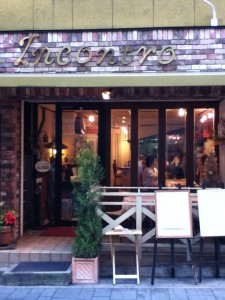
Japanese Italian pasta? Surely that must be a joke, right? In fact, when people ask me if Japanese sushi is really good, I usually reply: It’s great, as you would expect, but if you go there be sure not to miss out on the Italian pasta. Then the conversation partner usually looks at me like I’m an an alien, and then dismisses me as someone who obviously knows nothing about Japanese culture.
![]()
Kodawari
It is the same when I rave about the Japanese cake and Japanese bread. The best way to explain my enthusiasm for these seemingly out-of-place Western cuisines is to introduce a Japanese word, “kodawari” that captures the essence of Japanese food better than any word available in English. Kodawari, in essence, means the uncompromising pursuit of perfection with painstaking attention to detail.
Kodawari is an essential Japanese trait, and one of the main traits that differentiates the Japanese from other people and makes the Japanese culture unique. Kodawari can be found in all aspects of Japanese culture, but is particularly noticable in Japan’s food culture. Certainly kodawari is present in traditional Japanese cuisines like sushi, soba, etc., but it is also present in borrowed cuisines like Japanese ramen, which came from China, and even Western-based cuisines like Italian pasta.
![]()
Incontro Italian Pasta Review
So back from my digression, when you happen upon a little Japanese Italian pasta bistro, you can almost universally expect to find outstanding pasta, certainly better than what you can find in the U.S., and I dare say the best Japanese pasta rivals what you would find in Italy.
Incontro certainly fit the bill. A quaint little Italian bistro, Incontro offered up a couple of different specials: a 1,000 yen option that includes a garden salad, bread, a choice of the day’s pastas, and coffee or tea. We opted for the 1,300 option, that is basically the same except that it additionally includes two types of antipasto.
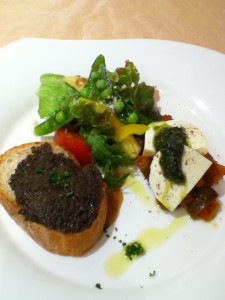
The bread arrived first and was, as expected, of high quality, and came with a fruity olive oil for dipping. Next came the antipasto: a toasted bread with an olive paste, and a mozzerella cheese red pepper concoction, accompanied by a tasty garden salad. The lone cook prepared each dish to order, allowing for a leisurely paced lunch.
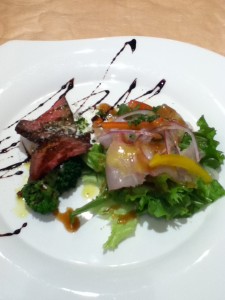
Finally, the pasta arrived. My wife ordered a tomato meat sauce pasta, which I didn’t taste since I don’t eat meat. Nami ordered a pasta arabiatta with minced tako (octopus), and I had a spinach, shrimp, and potato dish that was absolutely fantastic. Japanese pasta is always prepared perfectly al dente, and today was no exception. After we were finished eating, we were served pots of hot tea.
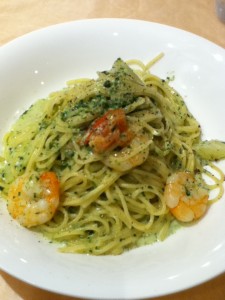
Considering that tipping is not required in Japan, the set menu was actually quite reasonable. In fact, most Japanese restaurants offer very reasonably priced lunch specials, so here’s an insider tip: if you want to enjoy dining in Japan and are on a budget, consider dining during lunch instead of in the evening.
Incontro is located just off the main boulevard on Daikanzaka St. Look for the Italian flag.
![]()
Stolling through Minato Mirai
After lunch, we parted ways with Nami for the day, and then went over to Pompoudor, a Yokohama-based bread bakery, to pick up some tasty bread. Then we strolled back through Yamashita Park and made our way over to Akarenga, a pair of old red brick warehouses converted into a mall of boutique shops and dining, for ice cream at a unique ice cream shop called Bashamichi Ice.
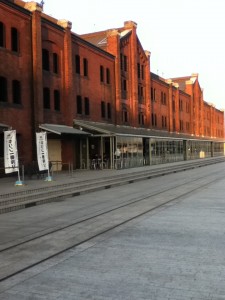
I ordered a murasaki-imo (purple sweet potato) flavored ice-cream, and yes it was fantastic!
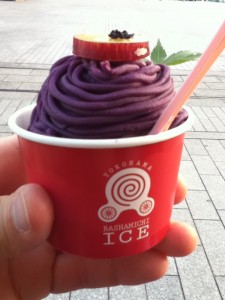
Then we checked out Colette Mall, the newest building in Sakaragicho, which includes a pristine upscale shopping and dining, as well as the New Otani Inn hotel. We came across a tofu ice cream shop, which we wanted to try, but we were quite full by this time so we decided to pass on this day. Then we took the train back to Toritsu and called it a day, but not before we were welcomed once again by Oba-san with an impressive spread of dinner. On the menu tonight was kaki fry, or fried oysters.
![]()
Kaki – Oysters or Persimmons?
Actually, the kaki fry reminded me of a kind of funny episode that occurred in the morning. We had just woken up, and Oba-san asked me if I wanted any kaki. Although reluctant to turn down any offering of food, oysters didn’t sound appealing first thing in the morning, so I politely refused. Oba-san pressed me to have some, and so I explained that I don’t really like to eat seafood in the morning.
At that, she began laughing, and explained that she wasn’t referring to kaki, the oyster, but rather, kaki the persimmon fruit. Now, my Japanese is quite advanced, but even I am prone to misunderstandings like this one. Japanese is full of homynyms, words that are pronounced identically but which have completely different meanings. However, it is quite rare for there to be two identical words that both refer to food.
In addition, the pronunciation is slightly different for each food. For kaki, the fruit, the intonation rises, and for the oyster, it drops on the second syllable. I wasn’t aware of the difference, and so I ended up turning down a tasty fruit, not unappealing morning oysters. Fortunately, my error was clarified and I got to eat the delicious persimmons. So here’s my quick Japanese lesson of the day:
Kaki–the fruit:
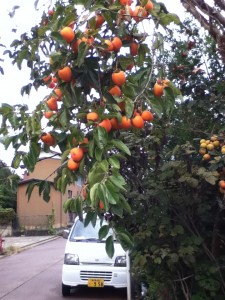
And kaki–the oyster:
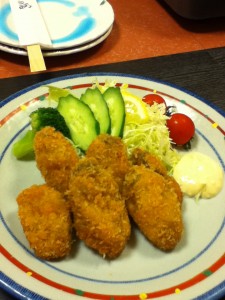
This little episode is one of the reasons I love living and visiting Japan: there is always something new to learn. Every moment is a challenge, and daily life is full of moments that include new and stimulating sights and sounds. Back in the U.S., daily life usually has a “been there done that” feeling. It is certainly easier to live in the U.S., but it isn’t necessarily more interesting.
![]()
